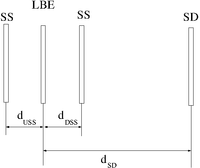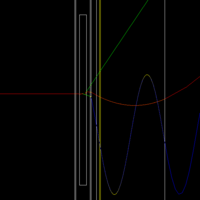Difference between revisions of "Niowave 2-2016"
(Created page with "The energy deposited by electrons scattered into a 3.48 diameter stainless steel beam pipe (1.65 mm thick) from a PbBi target as a function of a uniform Solenoidal magnetic fiel…") |
|||
| (6 intermediate revisions by the same user not shown) | |||
| Line 1: | Line 1: | ||
| − | + | Niowave Positron Project Progress for February 2016 | |
| − | |||
| − | |||
| − | |||
| − | |||
| − | |||
| − | |||
| − | |||
| − | |||
| − | |||
| − | |||
| − | |||
| − | |||
| − | |||
| − | |||
| − | |||
| − | |||
| − | |||
| − | |||
| + | Event files were generated for Niowave's beam line designers assuming an ideal solenoid having an inner radius of 2.527 cm surrounding a beam pipe with a radius of 1.74 cm. Electrons impinge a 2mm thick PbBi liquid target that has a surface area of 2.54 cm x 2.54 cm. Stainless steel windows 0.25 mm thick sandwhich the PbBi target at locations Z= -90.325 and Z= -89.875 cm. The target is located at Z =-90.1 cm and the beam begins 20 cm upstream at Z = -110.1 cm. The incident electron beam is a 0.5 cm radius cylinder. | ||
| − | + | Below is a table illustrating the target and stainless steel window geometry as well as a rare event where positrons were produced in the stainless steel window instead of the PbBi target. The solenoid design uses a maximum uniform field of 0.20 Tesla and a length of 150 mm. Twenty (20) million incident electrons with an energy of 10 MeV and forming a cylindrical beam with a 0.5 cm radius cylinder impinged a 2mm thick LBE target located at Z = -106 mm. The Z location of positrons exiting the beam pipe at the end of the 15 cm long solenoid is 44 mm. The positrons are 150.00 mm from the middle of the LBE target (Z=44mm). A space delimited text file with the above events in the format of | |
| − | + | PID, x(mm),y,z,Px,Py,Pz(MeV),t(ns) | |
| − | + | in units of cm for distance and MeV for momentum was delivered to Niowave | |
| − | |||
| − | |||
| − | |||
| − | |||
| − | |||
| − | |||
| − | |||
| − | |||
| − | |||
| − | |||
| − | |||
| − | |||
| Line 44: | Line 15: | ||
{| border="1" | {| border="1" | ||
| − | | [[File: | + | | [[File:TF_LBEtarg1_1-12-16.png | 200 px]]|| [[File:TF_LBEposEvent_1-12-16.png | 200 px]] |
| − | + | ||
| + | |- | ||
| + | | Closeup of Target Simulation Geometry. The center of the 0.25mm thick stainless steel windows are a distance of 2.25 mm from the center of the LBE target. <math>d_{USS} = d_{DSS} =</math> 2.25 mm, <math>t_{LBE}=2</math> mm, <math>t_{SS} =</math> .25 mm. || An example positron production event. The yellow lines represents a sensitive detector used to record positron events. The red line represents the incident 10 MeV electron that produces two bremsstrahlung photons shown in green. The first photon has an energy of 2.151 MeV and pair produces in the stainless steel window. The second photon has an energy of 1.393 MeV and exits the system without interacting. The first photon is created at time t= 3.323 ns. The first photon produces a 234.6 keV electron and a 894.2 keV positron at time t=3.336 ns. Only the positron has enough energy to exit the stainless steel window. | ||
| + | |+ Apparatus | ||
|} | |} | ||
| − | |||
| − | |||
| − | |||
Latest revision as of 15:33, 13 April 2016
Niowave Positron Project Progress for February 2016
Event files were generated for Niowave's beam line designers assuming an ideal solenoid having an inner radius of 2.527 cm surrounding a beam pipe with a radius of 1.74 cm. Electrons impinge a 2mm thick PbBi liquid target that has a surface area of 2.54 cm x 2.54 cm. Stainless steel windows 0.25 mm thick sandwhich the PbBi target at locations Z= -90.325 and Z= -89.875 cm. The target is located at Z =-90.1 cm and the beam begins 20 cm upstream at Z = -110.1 cm. The incident electron beam is a 0.5 cm radius cylinder.
Below is a table illustrating the target and stainless steel window geometry as well as a rare event where positrons were produced in the stainless steel window instead of the PbBi target. The solenoid design uses a maximum uniform field of 0.20 Tesla and a length of 150 mm. Twenty (20) million incident electrons with an energy of 10 MeV and forming a cylindrical beam with a 0.5 cm radius cylinder impinged a 2mm thick LBE target located at Z = -106 mm. The Z location of positrons exiting the beam pipe at the end of the 15 cm long solenoid is 44 mm. The positrons are 150.00 mm from the middle of the LBE target (Z=44mm). A space delimited text file with the above events in the format of
PID, x(mm),y,z,Px,Py,Pz(MeV),t(ns)
in units of cm for distance and MeV for momentum was delivered to Niowave

